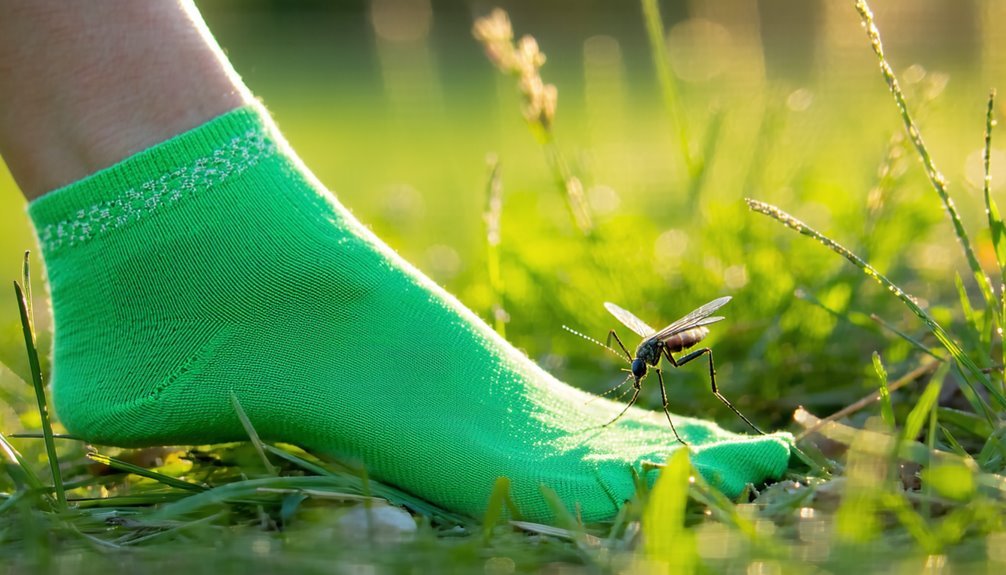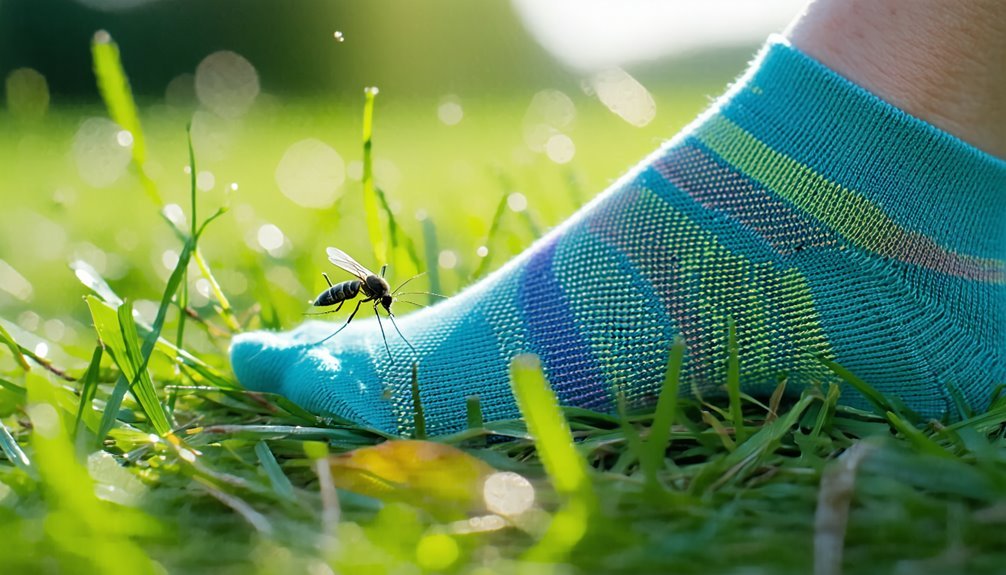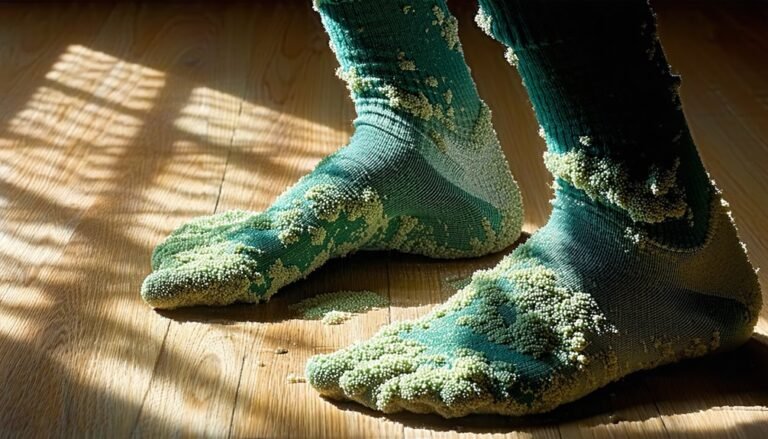Can Mosquitoes Bite Through Socks?
Mosquitoes can indeed bite through socks, especially if they're made of thin materials like cotton. Thicker, tightly woven socks, such as those made from synthetic fibers like nylon or polyester, offer better protection. Light colors can deter mosquitoes since dark colors attract them. Applying insect repellent around sock edges can further prevent bites. By exploring different sock materials and protection strategies, you can enhance your defense against these persistent insects.
Understanding Mosquito Anatomy and Feeding Behavior

Mosquito anatomy is specialized and fascinating, particularly when it comes to their feeding behavior. You should understand that mosquitoes possess a proboscis, a needle-like mouthpart designed for piercing skin and extracting blood. This structure is highly efficient, with multiple components working in concert to detect and penetrate their host's skin. Their feeding behavior is guided by keen sensory receptors that detect carbon dioxide, heat, and sweat, allowing them to target you precisely. Once they land, they use their proboscis to pierce the skin and extract blood, which is essential for egg production. It's important to recognize that mosquitoes can sometimes penetrate thin fabrics, raising concerns about exposure. Understanding their anatomy and behavior can help you take precautions to reduce the risk of bites.
The Material Matters: Fabric Choices and Mosquito Resistance
Fabric choice plays an essential role in determining your vulnerability to mosquito bites. To guarantee protection, opt for fabrics with high durability and tightly woven fibers. These materials present a formidable barrier against mosquito puncture attempts, as their dense structure limits the mosquito's proboscis from penetrating the fabric. Synthetic options like polyester or nylon are recommended due to their enhanced fabric durability and resistance to wear and tear. Natural fibers such as cotton may be more prone to punctures, offering less defense. Additionally, consider fabrics treated with insect-repellent finishes, which further reduce the likelihood of mosquito bites. Prioritizing these fabric characteristics in your clothing choices will greatly bolster your defense against mosquito-borne risks, safeguarding your health and comfort in mosquito-prone environments.
Thickness vs. Tightness: Which Socks Offer Better Protection?
While fabric choice greatly impacts mosquito resistance, the debate between thickness and tightness in socks is equally important. When considering sock fit, thicker socks generally offer superior bite prevention due to the additional material layer, creating a physical barrier that mosquitoes struggle to penetrate. However, tightness shouldn't be overlooked. Snug-fitting socks limit the space where mosquitoes can land and bite, enhancing protection further.
For ideal safety, you should aim for a balance: select socks that are both adequately thick and comfortably tight. This combination maximizes defense by minimizing exposed skin and ensuring mosquitoes face significant resistance. Prioritize high-density weaves and elastic materials that maintain their fit, as loose or stretched-out socks can compromise your bite prevention efforts.
The Role of Color in Mosquito Attraction and Deterrence

Have you ever wondered how the color of your socks might impact mosquito activity? Color psychology suggests that certain hues can either attract or repel mosquitoes. Dark colors like black and navy are known to enhance mosquito behavior, making them more likely to target you. This is because mosquitoes are drawn to heat, and darker colors retain heat more efficiently. Conversely, lighter colors such as white or pastel shades may deter mosquitoes by reflecting sunlight and reducing heat retention. Understanding the visual cues that influence mosquito behavior is essential for your safety. Wearing light-colored socks can be a simple yet effective strategy to minimize the risk of bites. By choosing the right colors, you can enhance your safety during mosquito-prone conditions.
Exploring Chemical Repellents and Treated Fabrics
Although mosquitoes are relentless in their pursuit of a meal, advancements in chemical repellents and treated fabrics offer effective defenses against these pests. Chemical repellents, such as DEET, picaridin, and IR3535, are scientifically formulated to block mosquitoes' ability to detect human scent. When applied to exposed skin, these repellents form a barrier that reduces the likelihood of bites. Similarly, treated fabrics, often infused with permethrin, provide protective clothing options. Permethrin-treated fabrics are designed to incapacitate or deter mosquitoes upon contact, offering an additional layer of defense. When choosing protective measures, consider combining chemical repellents with treated fabrics for ideal protection, especially in high-risk areas. These advancements prioritize your safety, ensuring that you can enjoy outdoor activities with minimal mosquito interference.
Environmental Factors Affecting Mosquito Activity
Mosquito activity is markedly influenced by environmental factors, which play an important role in their lifecycle and behavior. Temperature, humidity, and rainfall are critical determinants in their habitat preferences. Mosquitoes thrive in warm, humid climates, favoring stagnant water sources for mosquito breeding. You should be aware that areas with frequent rainfall create ideal breeding grounds, as they provide ample water for larvae development. Additionally, vegetation density offers mosquitoes shelter and moisture, enhancing survival rates. To guarantee your safety, understanding these environmental conditions is crucial. By minimizing stagnant water and maintaining controlled landscaping, you can reduce mosquito presence. Recognizing these factors allows you to anticipate mosquito activity, enabling proactive steps to protect yourself from bites and potential disease transmission.
Innovative Sock Designs for Mosquito Defense

When considering innovative sock designs for mosquito defense, you'll find that advanced fabric technology plays an essential role in preventing bites. These fabrics often incorporate tightly woven materials that create a barrier, greatly reducing the likelihood of mosquito penetration. Additionally, integrating chemical repellents into the fabric can enhance protection by emitting substances that deter mosquitoes from approaching.
Advanced Fabric Technology
While many assume standard socks are sufficient for mosquito protection, advanced fabric technology has revolutionized sock designs specifically for this purpose. To enhance your safety, these innovative socks prioritize fabric breathability and moisture management, guaranteeing comfort while protecting you from mosquito bites. Such socks employ tightly woven fibers that create a formidable barrier against mosquito proboscises. The table below illustrates key features of advanced sock technology:
| Feature | Benefit |
|---|---|
| Fabric Breathability | Guarantees airflow, reducing sweat |
| Moisture Management | Keeps feet dry, minimizes odor |
| Tight Weave | Prevents mosquito penetration |
| Lightweight Materials | Enhances comfort for prolonged wear |
Chemical Repellent Integration
Incorporating chemical repellents into sock designs marks a significant advancement in mosquito defense technology. By integrating various chemical repellent types into the fabric, these innovative socks aim to provide a protective barrier against mosquito bites. The effectiveness duration of these repellents is vital; some are formulated to last several hours, while others may extend up to several washes. For those seeking enhanced safety, understanding the science behind these designs is essential.
- Chemical Repellent Types: Different insecticides, such as permethrin or DEET, are used.
- Effectiveness Duration: Lasts anywhere from a few hours to multiple wash cycles.
- Application Method: Chemicals are often micro-encapsulated within fibers.
- Safety Standards: Adheres to health and environmental regulations.
- User Experience: Designed for comfort and breathability alongside protection.
Embrace these innovations for peace of mind.
Practical Tips for Reducing Mosquito Bites While Wearing Socks
To minimize mosquito bites while wearing socks, you should opt for thick, tightly woven materials, as these provide a more substantial barrier against the insects' proboscis. Additionally, applying insect repellent to the socks can enhance protection; ascertain the repellent is evenly distributed and covers any potential entry points. By combining these strategies, you can greatly decrease the likelihood of mosquito bites penetrating your socks.
Choose Thick Sock Material
Although mosquitoes may seem relentless in their pursuit of a blood meal, the thickness of your socks can greatly impede their ability to bite through. Selecting socks with increased sock thickness guarantees a stronger barrier. It's vital to opt for materials known for their material durability to withstand probing mosquito proboscises. Dense fibers and tightly woven fabrics can markedly enhance protection.
- Wool: Offers natural thickness and durability, creating a robust shield.
- Cotton blend: Combines comfort with a tighter weave, reducing vulnerability.
- Synthetic fibers: Such as nylon or polyester, provide elasticity and dense construction.
- Double-layered socks: Add an extra layer of defense against mosquito bites.
- Merino wool: Known for its fine fibers, balances comfort with effective thickness.
Prioritize these materials to enhance your safety.
Apply Insect Repellent Strategically
When aiming to reduce mosquito bites while wearing socks, strategically applying insect repellent can be highly effective. Focus on repellent application on exposed skin and areas where mosquitoes might find entry points, such as sock edges and around the ankles. Use a product containing DEET, picaridin, or oil of lemon eucalyptus for ideal protection. Remember, strategic placement is essential for maximizing effectiveness while minimizing chemical exposure.
| Area to Apply | Reason for Application |
|---|---|
| Exposed Skin | Direct deterrent from mosquito bites |
| Sock Edges | Potential entry point for mosquitoes |
| Around Ankles | Common mosquito attraction zone |
Frequently Asked Questions
Can Mosquitoes Bite Through Double-Layered Socks?
It's a coincidence you're curious about double-layered socks because sock thickness plays a crucial role. Mosquito anatomy, with its sharp proboscis, might penetrate thinner socks, but thicker layers generally provide better protection, enhancing your safety from bites.
Do Mosquitoes Prefer Certain Sock Colors Over Others?
You might wonder about sock color psychology and mosquito color attraction. Mosquitoes are generally more attracted to darker colors. Choosing lighter sock colors could potentially reduce mosquito attention, offering a safer choice when you're outdoors.
Are Certain Sock Brands More Mosquito-Resistant?
Like a knight's armor shields against swords, some sock brands offer better mosquito barrier effectiveness. When comparing sock materials, thicker, tightly woven fabrics are more resistant. Choose those for better protection, ensuring fewer bites and increased safety outdoors.
How Long Does Mosquito Repellent on Socks Remain Effective?
You're probably wondering about repellent longevity on socks. Typically, it lasts around 4-6 hours, but this varies with sock material. Dense, synthetic fibers might retain repellent longer than cotton, offering you better protection and safety.
Can Mosquitoes Sense Heat Through Socks?
You're curious about mosquito behavior, right? Mosquitoes can sense heat through socks due to their keen heat detection abilities. They navigate by detecting thermal emissions, making them adept at locating potential blood sources even through fabric barriers.







